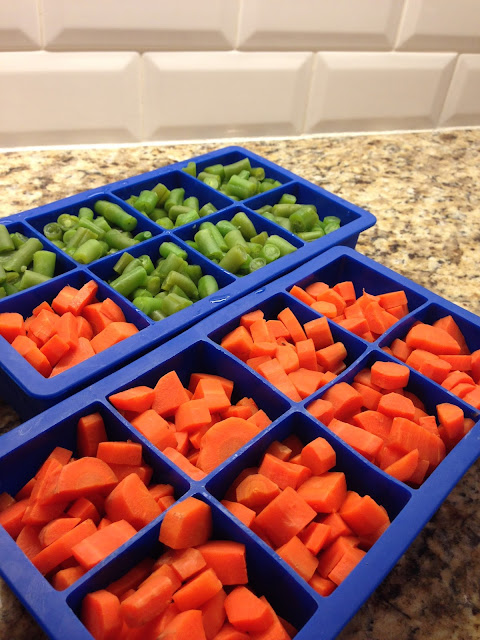Feeding C is so different now that he can pretty much eat most of what we eat. It's easier, in that I don't have to make separate food for him, but also a pain to cut up everything into little tiny bites (not to mention messier with how much ends up on the floor!)
For the most part, C can eat whatever we're eating. However, we normally eat salad with dinner every night, so I normally end up making C a different vegetable since he can't eat salad. If I'm using frozen vegetables (like I typically do for peas, broccoli, green beans, etc.), I'll usually just steam 1 or 2 portions (to have leftovers for the next day) at a time; for fresh vegetables (carrots, cauliflower, butternut squash, etc.), or frozen vegetables that are the steam-in-bag variety (so you have to make the entire bag at once), I'll make a huge batch at a time, cut them into bite-size pieces, and freeze them in 4-ounce portions in these silicone ice cube trays.
Then, I can just reheat a cube at a time, similar to how I did with his homemade baby food purees. This freeze-and-reheat method also works great for black beans (which I cook in a Crockpot using dried beans to avoid the salt content of canned beans) or leftover rotisserie chicken.
I'm always curious what my friends are feeding their 1-year-olds so I can get more ideas! Here are some of C's staples since about 11 months. I feed C mostly plain foods (without sauces, cheese, or casseroles) because I want him to taste the food itself and not cover it up by hiding veggies in a casserole or pasta dish.
- Broccoli (steamed from frozen)
- Green beans (steamed from frozen)
- Peas (steamed from frozen)
- Carrots (cooked from fresh, then frozen in 4-oz cubes)
- Cauliflower (cooked from fresh, then frozen in 4-oz cubes)
- Butternut squash (frozen steam-in-bag, then frozen in 4-oz cubes)
- Sweet potatoes (baked and/or grilled until soft, then cut into bite sizes)
- Avocado (fresh)
- Grape or cherry tomatoes (fresh, cut into bite sizes)
- Black beans (cooked in crockpot from dried, then frozen in 4-oz cubes)
- Pineapple (thawed from Trader Joe's frozen pineapple tidbits - already perfect bite size!)
- Berries (fresh, cut into bite sizes)
- Peach (fresh, cut into bite sizes)
- Mandarin oranges (fresh, cut into bite sizes)
- Grapes (fresh, cut into bite sizes)
- Bananas (fresh)
- Watermelon (fresh, cut into bite sizes)
- Cantaloupe (fresh, cut into bite sizes)
- Unsweetened organic applesauce (I used to make this myself until I discovered it is actually cheaper to buy it and the ingredients are the same - apples and water)
- Whole milk mozzarella cheese
- Applegate Naturals deli ham (I used to use the turkey but now avoid it because it contains carrageenan - more on that below)
- Grilled or rotisserie chicken
- Hamburgers
- Meatballs (from frozen)
- Dr. Praeger's veggie burgers
- Dr. Praeger's fish fillets
- Grilled salmon (wild caught)
- Whole wheat pasta (with or without sauce; I read labels to find spaghetti sauce that does not contain any sugar or high fructose corn syrup)
- Whole wheat toast with peanut butter (I read labels to find peanut butter with no added sugar or oil - just peanuts and salt. Our favorite brand is Laura Scudders)
- Scrambled eggs
- Homemade whole wheat oatmeal pancakes
- Fage 2% plain Greek yogurt (I do not give him the fruit-flavored kind because of the sugar content; he'll eat it plain - since he doesn't know there is an alternative - or sometimes I'll add applesauce and/or cinnamon)
- Organic whole milk
Reading labels
I try to avoid feeding C processed foods in general; for the exceptions, I always read the labels to make sure I recognize all of the ingredients (one reason I love Dr. Praeger's products) and there aren't any hidden sugars (peanut butter, applesauce, pasta sauce, yogurt, etc.)
Another ingredient I look for (and avoid) is carrageenan. Carrageenan is a seaweed extract found in many food products for its gelling, thickening, and stabilizing properties; it is often found in dairy products and dairy replacements because it can mimic the full-fat mouthfeel. Although its use is permitted by the FDA, many people experience gastrointestinal issues (gut irritation and IBS-like symptoms) resulting from ingesting carrageenan; since C is too young to tell me if his tummy hurts, I try to avoid carrageenan entirely. It is hidden in lots of things I wouldn't have expected - almost all milk substitutes (almond milk, soy milk, coconut milk), infant formula, lunchmeat (even Applegate Naturals brand turkey has it), sour cream, and even toddler "training toothpaste".

Another thing I check labels for is dairy pasteurization; C drinks organic whole milk with his meals and I make sure it is pasteurized but NOT ultra-pasteurized. For some reason, organic milk sold by the gallon tends to be pasteurized, while organic milk in the half-gallon-size container tends to be ultra-pasteurized (the label will specify which pasteurization was used). The downside of pasteurized (rather than ultra-pasteurized) milk is that it doesn't have as long of an expiration date (~21 days) as ultra-pasteurized milk (~70 days). C drinks almost exactly 1 half-gallon per week (2 meals per day on weekdays and 3 meals per day on weekends), so a gallon lasts us 2 weeks. Ultra-pasteurized milk is heated to a higher temperature, which kills more bacteria (including good bacteria/enzymes), allowing it to last longer before expiring. Ultra-pasteurization kills virtually all of the enzymes and bacteria to the point that the milk cannot even be cultured to make yogurt or kefir. It is commonly referred to as "dead milk", and, from the research I've done, pretty much negates the point of buying organic milk in the first place.




